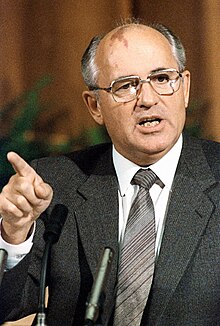The Cold War/Changes in the USSR
In 1985, Mikhail Gorbachev was unanimously elected as General Secretary of the Communist Party of the Soviet Union by the politburo. He was far younger (in his fifties) than his predecessors, and, although still a committed Marxist-Leninist, was far more open to western ideas. When he came to power, he found out what had previously been kept from him: that the Soviet Union had massive financial problems:
- A high percentage of the budget was being spent on subsidies.
- The Afghanistan War was proving to be both expensive and unsuccessful.
- The USA was putting on the pressure in the Arms Race, and the USSR did not have the money to keep up.
- A large proportion of factories were running at a loss.
- Military spending was high, and was difficult to cut, as no premier could afford to risk offending the Army.
- The USSR, through COMECON, was supporting many other Communist states, and was entirely responsible for keeping the Cuban economy afloat.

Solutions
editGorbachev, in an attempt to solve these problems by increasing efficiency and productivity, introduced two policies:
- Glasnost
This meant 'openness'. People were allowed to criticize the way the country was run, the media were no longer controlled, political prisoners were released, and, in 1990, free elections were held, with non-Communist candidates.
- Perestroika
This meant 'economic restructuring'. Gorbachev decentralized the economy, allowing small businesses, thus motivating people to produce more, more efficiently.
With regards to foreign policy, Gorbachev decided to let satellite states (such as those in Eastern Europe) go their own way - the USSR would not intervene in their affairs. One adviser called this the 'Sinatra Doctrine'.
Problems caused by the Solutions
editThese changes inevitably caused problems. Because of glasnost, people were, after years of repression under leaders like Stalin and Brezhnev, finally allowed to say what they thought about the government. Perestroika just was too little change, far too late to make any difference to the economy. Some good products were imported, but only enough to whet people's appetites so that they wanted more, but could not get it. People were still scared of the repression that they had lived under for so long, so not enough small businesses were created. In short, glasnost and perestroika meant that people started to protest more, paving the way to the breakup of the Soviet bloc in 1989, and the coup of 1991 which eventually lead to Gorbachev's resignation and the end of Communism in Russia.
The Cold War
Introduction - Background - Strategy - Truman Doctrine - Marshall Plan - Berlin Blockade - Korean War - Hungarian Uprising - Cuban Missile Crisis - USSR under Gorbachev - USA under Reagan - Arms Race - Space Race
Cover - Contents - Study Guide
Please read the page creation guidelines before creating a new page.